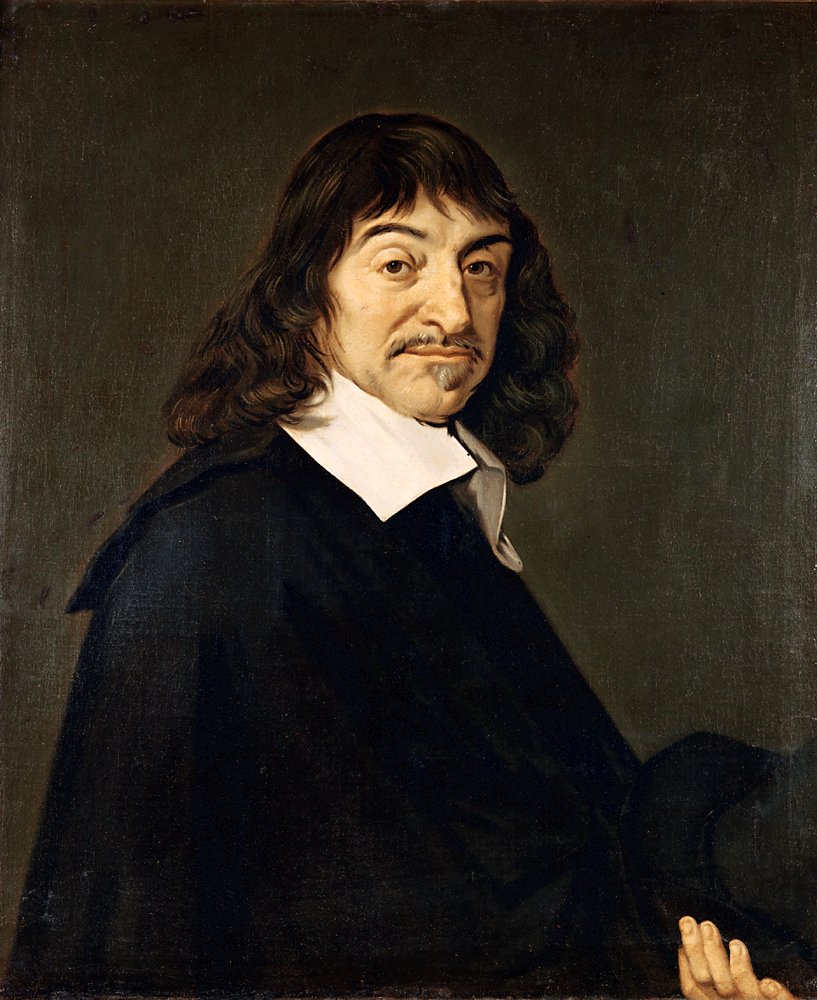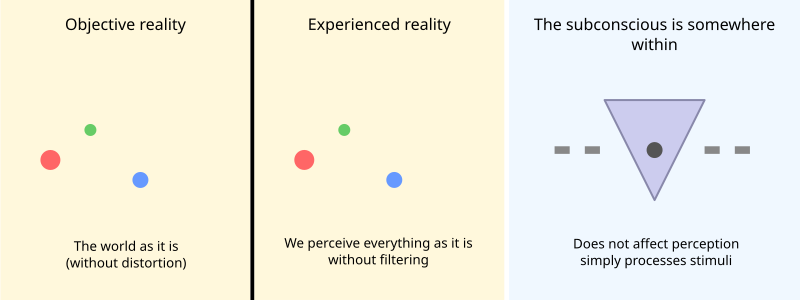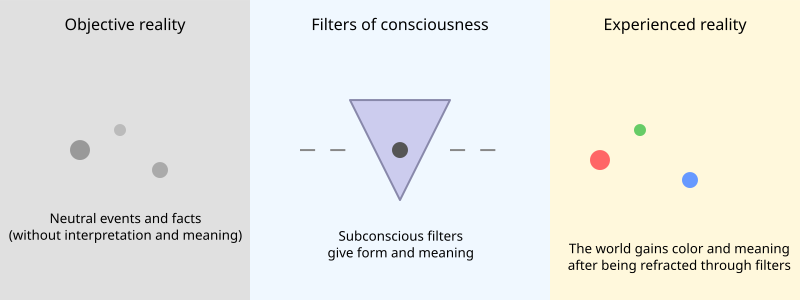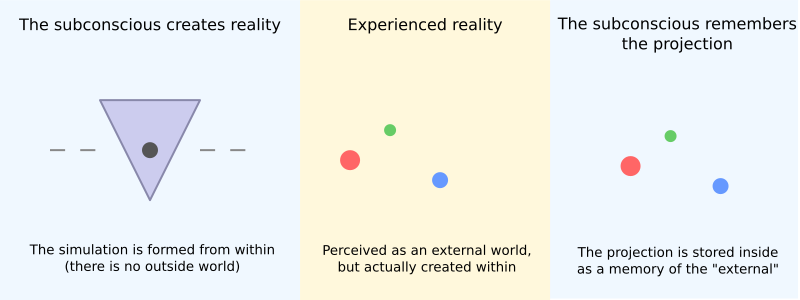Contents
- Introduction
- Solipsism — The First Point of Doubt
- Three Models of Perceiving Reality
- 🔍 Limitations of Model 1 (Naive Realism)
- 🔍 Limitations of Model 3 (Solipsism)
- More on Model 2: The Dual Level of Meaningful Perception
- 🧭 The Position of Deconstruction of Reality
- 🔄 Meaning as a Form of Perception: You Don’t See the World, You See Meaning
- The Subconscious as the Magic of Filters
- Conclusion
Introduction
What if the whole world around you is just an illusion generated by your own consciousness? This thought is both frightening and liberating.
Where does the deconstruction of reality begin? With the recognition that everything you perceive passes through you. You do not see “the world.” You see a projection of the world, filtered by your consciousness. This isn’t a philosophical riddle—it’s the basic structure of human perception.
Solipsism — The First Point of Doubt
Solipsism claims: nothing except my own consciousness is guaranteed. Everything you feel, see, hear, or think may be a dream, an illusion, a glitch, or a simulation.
This is not to say that “nothing exists.” It is a stance of radical honesty: you cannot step outside your own consciousness to verify it.
This idea goes back to the philosophy of René Descartes (1596–1650)—a French philosopher, mathematician, and natural scientist, considered one of the founders of modern scientific thought. He developed the method of systematic doubt as a foundation for philosophical analysis, laid the groundwork for rationalism, and profoundly influenced analytic geometry. Descartes was the first to combine algebra and geometry, introducing the coordinate system that later became the basis for the concept of vector space. His contributions bridged the gap between ancient philosophy and the science of the modern era.

Descartes questioned the reliability of sensory experience and refused to blindly trust the authorities of the past. He aimed to build science on clear and self-evident principles of reason, logic, mathematics, and the inner certainty of thought. In this way, his approach became a transitional point from the metaphysics of Plato and Aristotle to the empirical science of Galileo and Newton.
His famous Cogito, ergo sum — “I think, therefore I am” — became the cornerstone of Western philosophy and the starting point for the subjective approach to reality. Descartes doubted everything except the very act of thinking and showed that the only undeniable given is the fact of thinking itself, happening in the present moment. Even if everything else is an illusion, the process of thinking proves the existence of the subject who experiences it.
Later, this idea was developed in phenomenology—a philosophical movement of the late 19th and early 20th centuries. Its founder was the German philosopher Edmund Husserl (1859–1938), and among its key followers was another German philosopher, Martin Heidegger (1889–1976). Phenomenology does not study “things in themselves” but analyzes the structure of experience: how phenomena are given to consciousness. It claims that it is consciousness that gives things their meaning, so reality is impossible outside of subjective experience.
In the 20th century, constructivism emerged—a movement that emphasizes that knowledge and “reality” are created by humans. Notable representatives include Jean Piaget (1896–1980), the Swiss psychologist, and Ernst von Glasersfeld (1917–2010), philosopher and educational theorist. They argued: we do not discover reality as something already given—we construct it, relying on cognitive schemas, language, and cultural codes.
These directions continue the line started by solipsism but focus not on doubt, but on the creative, generative role of consciousness. From philosophical distrust, we move to the idea: the world we live in is a product of our perception and thinking.
From this starting point, the questions arise:
- What is perception?
- How does consciousness create our picture of the world?
- Is there any access to reality outside of subjective experience?
Three Models of Perceiving Reality
If we accept that all our knowledge of the world passes through consciousness, the question arises: how exactly does this process of perception work? There are at least three models, each offering its own ontology:
Model 1. Direct Reality or Naive Realism
I see the world as it is
Objective reality exists. Consciousness perceives it directly, without distortion. No filters. What we see, hear, and sense is what is actually happening.
The subconscious, in this model, plays a supporting role: it is located “behind” and is engaged in processing incoming signals, making decisions, and responding to stimuli.
This is the default philosophy for empirical science in the 19th and 20th centuries. Naive realism underlies classical materialism and the view of the world as objectively existing and accessible through observation that is still considered “scientific” by many popularizers and those who call themselves scientists.

Model 2. Reality Through Filters or Semantic Dualism
The world exists, but it gains shape and meaning only through the filters of my consciousness
According to this model, perception is not a direct reflection of objective reality. It is always mediated by filters—structures through which external experience passes before becoming conscious. These filters may include unconscious biases, cultural templates, memory, and language.
Consciousness receives not the “raw” world but an already meaningful experience—the result of the active assembly of reality, not its passive reception. This brings model 2 closer to constructivism and cognitive science.

Model 3. Reality as Projection or Solipsism
I cannot prove that anything exists besides my own consciousness
According to this model, objective reality as such does not exist. Everything perceived as the “external world” is the inner content of consciousness or the unconscious.
Consciousness experiences what seems to be external, but in fact, it is projected from within. The world is a simulation generated by the psyche itself.
This position is found in radical idealism, Eastern metaphysics (e.g., Buddhism), and the philosophy of solipsism, according to which the existence of anything outside one’s own consciousness cannot be proven.

Comparative Table of Key Concepts
| № | Model Name | External Reality | Role of Filters | Source of Perception |
|---|---|---|---|---|
| 1 | Naive Realism (direct givenness) | Yes | None | External world |
| 2 | Semantic Dualism (reality through filters) | Yes | Yes (meaning-making filters) | External world, interpreted through filters |
| 3 | Solipsism (reality as a projection of consciousness) | No | Not needed | Consciousness (or the unconscious) |
🔍 Limitations of Model 1 (Naive Realism)
Model 1 presents reality as “just as it is”—supposedly objective, available to all observers equally. There are no filters: the senses register signals directly, and most “matching observations” are taken as confirmation of objectivity. But in reality:
- Illusion of objectivity: if everyone sees the same thing, this does not make perception objective. Everyone sees through similarly structured sense organs and cultural patterns.
- No filters—no meaning: in this model, perception is not meaningful—it’s just a data stream without interpretation.
- Blindness to inner experience: the model ignores the difference between “data” and “experience.” But it is experience that makes our reality personal and real.
🔍 Limitations of Model 3 (Solipsism)
Model 3 claims that everything that exists is a projection of consciousness, and the external world may be an illusion or may not exist at all. This position is philosophically radical and logically consistent, but impractical:
- Unverifiability: you cannot prove or disprove the existence of other minds or the external world—this puts the model beyond rational analysis.
- Self-contradiction: if everything is an illusion, then the very act of presenting this idea and trying to convince anyone loses meaning.
- Closed loop: consciousness in solipsism is isolated—without a point of reference, without external challenge, without a difference between dream and reality.
- Ignores coherence of experience: culture, language, and scientific knowledge all require a shared reality beyond individual consciousness.
Solipsism is interesting as a starting point for philosophical inquiry, but it does not provide a constructive account of how we interact with and change reality.
More on Model 2: The Dual Level of Meaningful Perception
Model 2—”Reality Through Filters or Semantic Dualism”—is not just one philosophical stance but a range of perspectives united by the idea that we do not see reality directly, but neither are we locked within individual consciousness. This model offers a two-layered structure of perception:
🔹 Level 1: Operational (Cognitive-Psychological)
At this level, the model describes consciousness as a result of filtering external experience. These filters are not distortions but necessary mechanisms:
- attention,
- memory,
- language,
- emotional states,
- cultural and personal attitudes.
These mechanisms don’t just register signals—they actively give them shape and meaning. As stated above, perception is always meaningful.
🔹 Level 2: Metaphysical (Semantic Field)
This level goes beyond psychology. Here, the idea is introduced that there exists a non-material field of meaning containing:
- meanings created by consciousness,
- meanings existing independently of consciousness,
- structures that attract consciousness and organize experience.
In this model, consciousness is not the source of reality, but a participant and conductor. It interacts with the semantic field, enabling it to read, integrate, create, and disseminate meaning-forms.
🧩 How Does This Combine?
Filters of perception act as selection mechanisms: they determine which meanings are received from the field, which remain “out of range,” and which forms are ultimately materialized in individual experience. Thus, consciousness:
- does not distort reality,
- but extracts specific structures from it.
Why Is This Important?
Without distinguishing these two levels, Model 2 remains either purely psychological (and thus repeats constructivism) or drifts into pure metaphysics (and becomes speculative). But the combination of both layers is the core of the philosophy of Deconstruction of Reality.
🧭 The Position of Deconstruction of Reality
The Deconstruction of Reality project adopts the second model of perception—reality through filters, but goes deeper, revealing its dual nature: psychological and ontological.
Consciousness is not a closed capsule, nor an objective camera. It operates as a navigation system tuned to semantic fields. These fields are not a metaphor, but a real non-material layer of being where meanings exist as structures, gravitational nodes, and trajectories of thought.
Meaning is not a product of the brain. It is an original form that consciousness can read, interpret, and embody. Perceptual filters are not distortions but resonance settings that determine which meanings become available.
Consciousness can not only read meanings, but also embed new forms in the field, which then begin to live and act in the minds of others.
📌 Semantic Gravity
Meanings recorded in the semantic field possess not only structure but also dynamics. They can attract consciousness—the more consciousnesses connect to a particular meaning, the stronger its influence on perception and behavior. This is described as the gravity of meaning.
- Local meanings (personal beliefs) act at the individual level.
- Collective meanings (religions, ideologies, scientific paradigms) shape the thinking of whole societies.
- Civilizational meanings change the course of history.
Consciousness can not only participate in these systems but also consciously choose whose orbit to enter, and with sufficient strength, even create its own semantic constructs capable of attracting others.
🔄 Meaning as a Form of Perception: You Don’t See the World, You See Meaning
So, you never see the “raw” world. Everything you perceive is already meaningful.
Every act of perception is not a reflection, but an act of semantic tuning. You don’t just encounter an object—you immediately see it in semantic form.
It is not “perception → meaning.” Meaning is already built into the very act of perception.
Meaning is not the result of perception, but its condition.
You do not first see, then interpret.
You immediately see meaning.
That’s why two people can see the same thing, but live it differently.
Meaning is not in the object, but in the filter. The filter creates the event as meaningful, frightening, or beautiful.
If you have an ingrained belief—say, “I am a failure”—then any glance from a passerby, a friend’s silence, any random event will be perceived as confirmation of that belief.
The world has not changed. But the meaning is already chosen, even before you are aware of it.
This phenomenon is described in:
- cognitive science—as cognitive biases (stable semantic patterns embedded in consciousness),
- psychology—as apperception (perception colored by past experience),
- philosophy—as mediation (the indirectness of knowledge of the world),
We do not just perceive the world. We perceive meanings. And it is they that form the reality we live in.
The Subconscious as the Magic of Filters
The point where reality is refracted is not the surface of consciousness, but its depths. The subconscious is not the psychic garbage bin. It is the interpreter, editor, and dramatist. It decides what meaning you will invest in what you see.
Imagine your mind as Photoshop, and the filters of perception as layers and effects. The same frame can be made tragic, romantic, absurd, or majestic—just by changing the set of filters.
That’s how perception works: the form is the same, but the meaning is what you put into it.
⚠️ The mistake is to take meaning for reality itself.
The same fact can be:
- a threat,
- an opportunity,
- nonsense,
- a revelation
For example, a man stands with flowers in front of a door.
- The romantic: “He wants to apologize to his beloved.”
- The neighbor: “They’re fighting again, probably.”
- The psychologist: “He is projecting guilt.”
- The cynic: “Just another guy who messed up.”
- The artist: “This moment needs to be drawn.”
The same external fact can be interpreted entirely differently, depending on the observer’s filters.
Every consciousness is a unique projector, overlaying its meaning on the common form. We all look at the same “picture,” but each of us sees our own movie.
“The map is not the territory.”
— Alfred Korzybski
Conclusion
Solipsism is not a dead end, but a starting point. It does not reject reality, but reveals: you are not just an observer, you are a co-author. What you see does not necessarily exist outside you. But everything you see carries meaning. And that meaning is yours.
You look through the lenses of perception, but you can change them. Every sensation, every thought, is not a reflection of the objective world, but a reflection of your inner architecture.
And this is where it all begins. Not with the question “what is real?”, but with the question “what do I invest in reality?”.
Understanding the mechanisms of perception is not philosophy. It is the key. To freedom. To responsibility. To meaning.